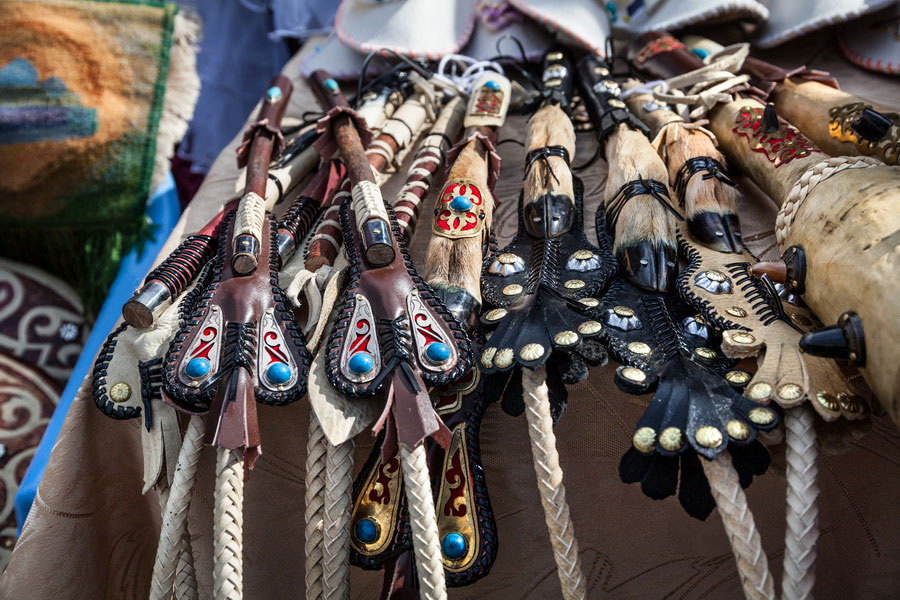
The harsh conditions of a nomadic life on the steppe and the difficult reality of subsistence farming forced people to produce all necessities on their own. Kazakh folk craft tradition was thereby borne out of that necessity, with items meeting the needs of the people and rarely being used for trade. Amongst nomadic tribes, the type of handicraft work was delegated by gender: men were engaged in the processing of wood, metal, leather, and other types of industries that require strength and were traditionally associated with male activities; women worked in areas where perseverance and hard work were needed—making and processing felt or wool and various types of weaving and embroidery.
With Kazakhstan’s incorporation into the Russian Empire at the beginning of the 19th century, the development of trade led to a decline in the role of folk crafts. Newly imported raw materials did allow artisans to expand their capabilities and implement new ideas, however. As a result, crafts became the prerogative of individual specialists who began to create products exclusively for sale. Today, handicrafts are a reflection of the rich nomadic culture of Kazakhstan, and handicrafts mainly serve as gifts and souvenirs.
Woodworking
Wood was one of the most important materials in the life of Kazakh nomads. Their yurt frames, furniture, dishes, and other household items were all made from various types of wood.
Woodworking mostly began in Northern Kazakhstan—because the area is heavily forested—and was spread as the population dispersed. The most important aspect of woodworking was the manufacturing of yurt parts: the kerege wall lattices, yuk roof rails, and shanyrak rim. Creating a strong and geometrically correct framework for a permanent home required excellent craftsmanship. Additionally, the “shanyrak”, the most complex and important construction, was often passed down from generation to generation and could be decorated with various carved ornaments.
Some saddle pieces, tool handles, and various lockers and chests were also made of wood. The making of musical instruments constituted a separate type of craft—most notably, the “kobyz” and “dombra” took special skill.
Metal
Metals were less common materials for artisans, but blacksmithing was an important skill in the life of nomads—horseshoes, stirrups, harness parts, knives, and other tools were made from various metals. Metallurgy and metalworking were mostly poorly developed industries, and with the development of trade, imported products almost completely replaced local production. Skills in metalworking were still applied by Kazakh jewelers, however, a tradition that continues today.
Leather
Leathercraft was another important aspect of Kazakh life. Winter clothes, hats, saddle detailing, and various armors were all made from the treated skins of wild and domestic animals. Some types of clothing were so comfortable and of such a high quality that they became popular throughout the region and were prized in the bazaars along the Silk Road. In addition, nomads made leather vessels for water and koumiss. Shoemaking was also a valuable skill amongst the nomads—Kazakhs wore boots in both the summer and winter. Although traditionally seen as a masculine undertaking, women were often involved in leatherworking as well.
Felt and Weaving
The manufacture and processing of felt was a fundamental craft in Kazakh nomadic life and an important role for women. Most importantly, felt was used to cover yurts. It was also used for sewing shoes and slippers, and a thin felt was the material for various clothes. Felt served as the basis for the tekemet carpet, which covered the floor in the yurt, and for the beautiful tuskyis carpets that adorned yurt walls. This type of carpet weaving from wool or other types of thin strips of fabric was a well-developed tradition—in more ancient times, mat weaving was also widespread.
Jewelry and Bone Carving
Kazakhs have a well-respected history for jewelry making and are experts in many of the associated metalworking techniques: forging, stamping, and others. Most pieces are silver, although gold is also used. From these materials, jewelers create various rings, bracelets, earrings and pendants, as well as details of clothing—adornments such as buckles and buttons. Bone carving was another special type of Kazakh craft. Craftsmen carved various figures from the bones and horns of animals. Thin plates with various patterns were also made and used as furniture inlays.

